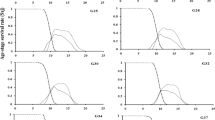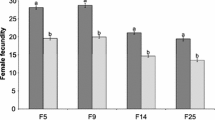Abstract
A comparative study was made of the fertility, fecundity and longevity ofTrichogramma confusum Vigg. reared in the laboratory on eggs ofCorcyra cephalonica St., vs. a wild type population of the same species.
Laboratory reared females showed a significantly higher degree of sterility than wild-type females while sterility amongst males did not differ significantly. Under laboratory conditions, laboratory reared females lived longer than wild-type females but produced fewer progeny as indicated by life-table data suggesting that their “effective” life is shorter.
The high precentage of sterility amongst laboratory reared females should be taken into account when making inundative field releases. As size of the host may influence the fecundity and behaviour of laboratory rearedTrichogramma, the use of a suitable host which produces larger eggs would have to be considered in any mass-breeding programme.
Résumé
On a comparé la fertilité, la fécondité et la longévité deTrichogramma confusum Vigg. élevés sur des œufs deCorcyra cephalonica St. par rapport à une population sauvage de la même espèce. Les femelles d'élevage présentent une stérilité significativement plus élevée que les femelles sauvages alors que la stérilité des mâles est sensiblement la même. Au laboratoire les femelles d'élevage vivent plus longtemps que celles de la nature mais ont une descendance moindre d'après les données de la table de survie montrant que leur vie effective est plus courte. Le pourcentage élevé de stérilite constaté chez les femelles d'élevage doit être pris en considération pour les lâchers inondatifs dans les champs. Puisque la taille de l'hôte peut influencer la fécondité et le comportement desTrichogramma en élevage, l'utilisation d'un hôte produisant des œufs plus gros que ceux deCorcyra serait à considérer pour la production de masse.
Similar content being viewed by others
References
Andrewartha, H. G. & Birch L. C. — 1954. The distribution and abundance of animals. —Univ. Chicago Press, 782 pp.
Ashley, T. R., Gonzalez, D. &Leigh, T. F. — 1973. Reduction in effectiveness of laboratory-rearedTrichogramma. —Environ. Entomol., 2, 1069–1073.
Boldt, P. E. &Marston, N. — 1974. Eggs of the greater wax moth as a host forTrichogramma. —Environ. Entomol., 3, 545–548.
Davis, C. P. &Burbutis, P. P. — 1974. The effect of age-selective rearing on the biological quality of females ofTrichogramma nubilalum. —Ann. Entomol. Soc. Am., 67, 765–766.
Flanders, S. E. — 1929. Billions of insects to fight man's battles. —Science News Letter, 289–291.
— — 1945. Mass production ofTrichogramma using eggs of potato tuber worm. —J. Econ. Entomol., 38, 394–395.
Marston, N. &Ertle, L. R. — 1973. Host influence on the bionomics ofTrichogramma minutum. —Ann. Entomol. Soc. Am., 66, 1155–1162.
Ordish, G. — 1969. Integrated control in Peruvian cotton. —PANS, 15, 37–40.
Phalak, V. R. — 1970. A note onDiadegma varuna Gupta [Hymenoptera: Ichneumonidae], a parasite ofPlutella xylostella (Linnaeus) [Lepidoptera: Plutellidae at Kalimpong (West Bengal). —Curr. Sci., 39, 375–376.
Pu Chih-Lung, Tang Te-Hai, Liu Chih-Cheng, Hung Fu-Chang &Mo Yu-Shi. — 1956. On the rearing ofTrichogramma evanescens Westw. and its utilization for the control of sugar cance borers. —Acta Entomol. Sinica, 6, 1–35.
Rajendram, G. F. &Hagen, K. S. — 1974.Trichogramma oviposition into artificial substrates. —Environ. Entomol., 3, 399–401.
Schieferdecker, H. — 1968. Zur Biologie und Massenzucht der GetreidemotteSitotroga cerealella Olivier. I. Beitrag: Zur Eiablage vonSitotroga cerealella Olivier. —Beitr. Entomol., 18, 329–345.
Southwood, T. R. E. — 1966. Ecological Methods. —Methuen, Lond., 391 pp.
Telenga, N. A. — 1958. Biological method of pest control in crops and forest plants in the U.S.S.R. —9th Int. Conf. Quar. Plant. Prot., Moscow, 1–15.
Ulrich, H. — 1968. Ein verbesserter Käfig fur die Massenzucht des EiparasitenTrichogramma [Hymenoptera, Chalcidoidea]. —Entomophaga, 13, 233–236.
Viggiani, G. — 1976. Ricerche sugliHymenoptera Chalcidoidea XLIX.Trichogramma confusum n. sp. perT. australicum Nagarkatti etNagaraja (1968), necGirault (1912), con note suTrichogrammatoidea Girault e descrizione diParatrichogramma heliothidis n. sp. —Boll. Lab. Entomol. Agr. Filippo Silvestri, 33, 182–187.
Author information
Authors and Affiliations
Additional information
This research was financed by the Indian Council of Agricultural Research, New Delhi.
This is the same species as that referred to by the authors in their earlier papers asT. australicum Gir. After comparison of paratype material it has been renamed asT. confusum byViggiani (1976).
Rights and permissions
About this article
Cite this article
Nagarkatti, S., Nagaraja, H. Experimental comparison of laboratory reared vs. wild-typeTrichogramma confusum [Hym.: Trichogrammatidae] I. Fertility, fecundity and longevity. Entomophaga 23, 129–136 (1978). https://doi.org/10.1007/BF02371719
Issue Date:
DOI: https://doi.org/10.1007/BF02371719




